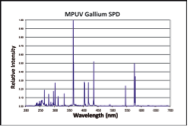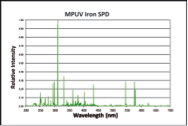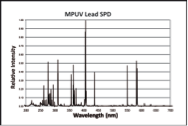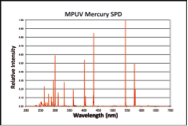MPUVA curing lamps are much higher power than a Low Pressure (LP) germicidal lamp. Standard MPUVA mercury curing lamps have wavelength output peaks at 254nm and 365nm. Other applications call for higher wavelength peaks such as 385nm and 417nm. To reach these additional radiation peaks – additive lamps are created by dosing the lamps with heavy metal compounds (metal halide). Commonly requested additives for MPUVA lamps are Gallium (400-450nm), Lead, and Iron (350- 400nm). When adding a metal halide to a lamp, all the characteristic wavelengths of that metal will be produced and the mercury spectra will have its lines lowered/changed in intensity. All the materials in the arc are interactive. Metal halide lamps also require specific ballasts designed to operate. The starting voltage for an additive lamp is higher than for a standard mercury lamp by several hundred volts and can vary with lamp age and number of times the lamp is ignited.
(The prediction intensity for specific lines in a metal halide lamp can only be stated based on the lines listed in spectroscopy manuals as “strong” lines and “persistent” lines will be more intense.)






